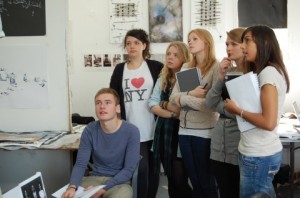 They get to use what they have learned in college?:
They get to use what they have learned in college?:
Among … respondents employed at the time they completed the survey, 64% of recent grads and 69% of prior graduates were in jobs they described as either “very relevant” or “relevant” to their educational training.
Or not?:
The majority of arts graduates work in non-arts fields. Out of 2 million arts graduates nationally, only 10 percent, or 200,000 people, make their primary earnings as working artists.
Let’s try to sort out how and why the recent report from the Strategic National Arts Alumni Project (SNAAP),* the source of the first quote, differs from the BFAMFAPHD National Study on the Lives of Arts Graduates and Working Artists, the source of the second quote.
BFAMFAPHD is based upon the Census Bureau’s 2012 American Community Survey (ACS), which captures about 3 million households. ‘Artists’ are those who list it as a primary occupation, and this is compared with the respondent’s ‘field of degree’. The survey indicates that there are 1.2 million working artists, 2.0 million Americans with an arts degree, but only 200,000 who are both. They note ’40 percent of working artists do not have a bachelors degree in any field. Only 16 percent of working artists have arts related bachelors degrees.’ Also note designers and architects are excluded from both ‘artists’ and ‘field of degree.’ There is a tone of concern throughout the report, arising from the fact that arts schools are expensive relative to other degrees (net of financial aid), and so student debt is a problem (this comes up in both reports).
As an aside, let me insert these thoughts when looking at student debt numbers:
- Studies consistently show that obtaining a college degree is a sound monetary investment, so acquiring debt to finance the degree is not on its own a sign of financial crisis;
- But financing the debt can be a challenge; lending markets are notoriously imperfect when it comes to student loans, so the schedule of repayments (rather than the debt level itself) often presents a problem, especially when the ‘payoff’ from a degree might not really manifest itself for years (see here for a good analysis from the Brookings Institution);
- The payoff is for a degree, not for ‘some college’, so acquiring debt is a risk if the student does not have good odds of finishing her studies.
How is SNAAP different from BFAMFAPHD?
- SNAAP administers its own survey, rather than using the ACS;
- SNAAP is based on surveys of graduates from participating institutions – 140 postsecondary and 13 arts high schools. It is a survey of arts graduates of these institutions, not of working artists.
- SNAAP does include design and architecture.
But the big difference between the two reports is this: SNAAP does not indicate what portion of its surveyed alumni have ‘artist’ as primary occupation. I find this a very strange omission (and please correct me if I just didn’t see it in the report!), especially since results are included (Figure 6, p. 17) as to reasons given by respondents for ‘not working as a professional artist’ (better pay elsewhere, no work, family reasons, etc.). So the proportion of alumni working as artists must be known. I don’t get it; it’s an important number.
And so, the two surveys do not necessarily contradict each other: it could well be that only 10 percent of arts alumni end up working as professional artists, but that 64 percent of recent arts alumni are in jobs where their training is ‘relevant’ to their current work.
*Disclosure: I work at Indiana University, home base for SNAAP, though I don’t work for them, and I had no hand in this project.
UPDATE: See Professor Jennifer Lena in the comments below: she has the numbers – 51 percent of recent graduates from the SNAAP survey working as professional artists.
MORE UPDATE (November 7): The Atlantic: ‘… art school programs need to be a lot more honest with their students.’

Hi, Michael,
I saw your inquiry and us good people at SNAAP found the numbers you requested.
51% of recent graduates (the focus of my 2014 SNAAP annual report) are current professional artists, v.s. 54% of non-recent graduates.
64% of recent graduates spend the majority of their time in an arts-related occupation, compared with 67% of non-recent graduates.
These results allow you a choice between two ways to define the population that have “artist as a primary occupation”: Is it self-description as “currently a professional artist” or those who spend the majority of their work time in an occupation related to the arts?
Hi Jennifer, Many thanks for the quick find on the numbers! And quite different from the ACS survey, will be an interesting project to reconcile the findings.